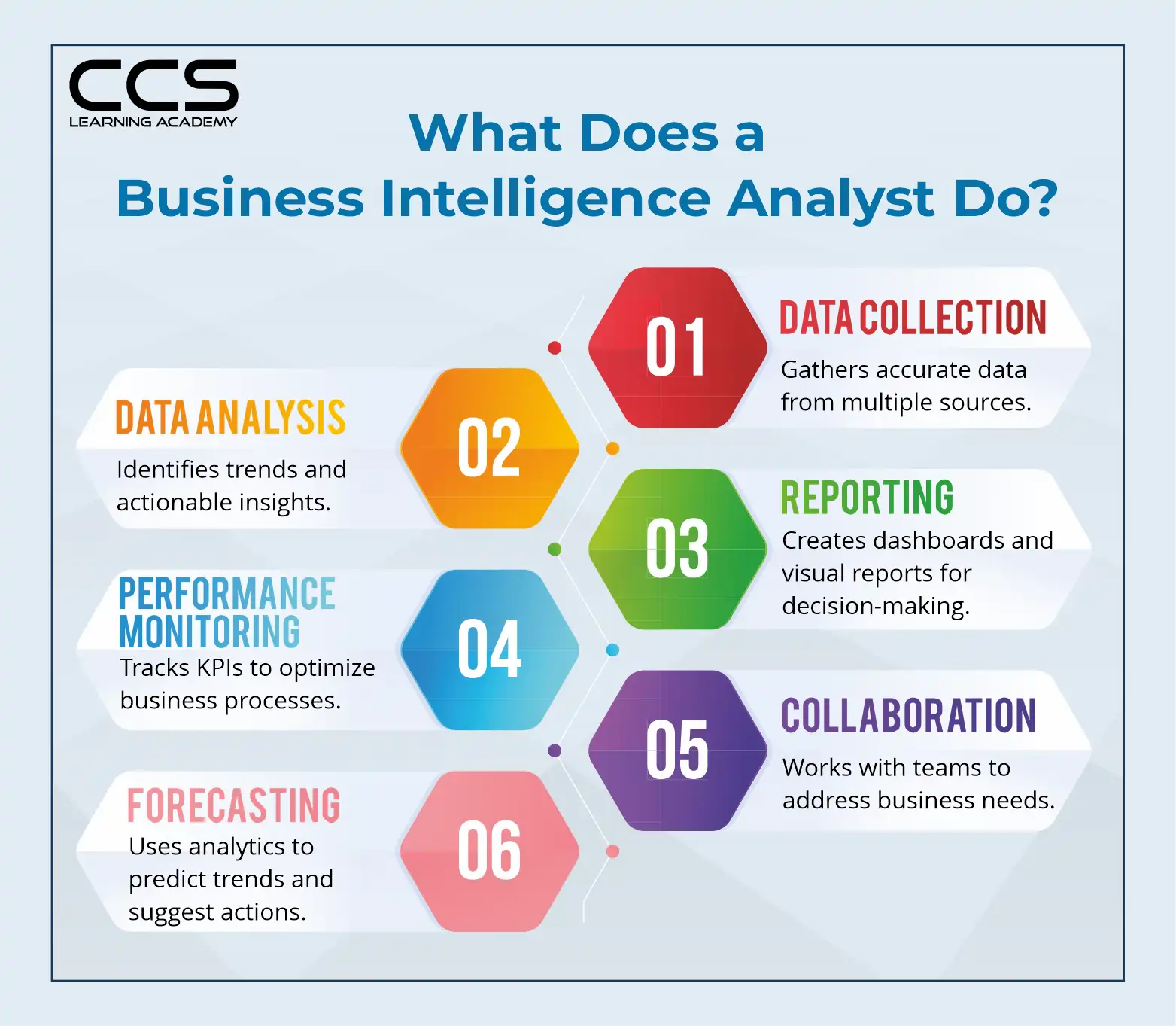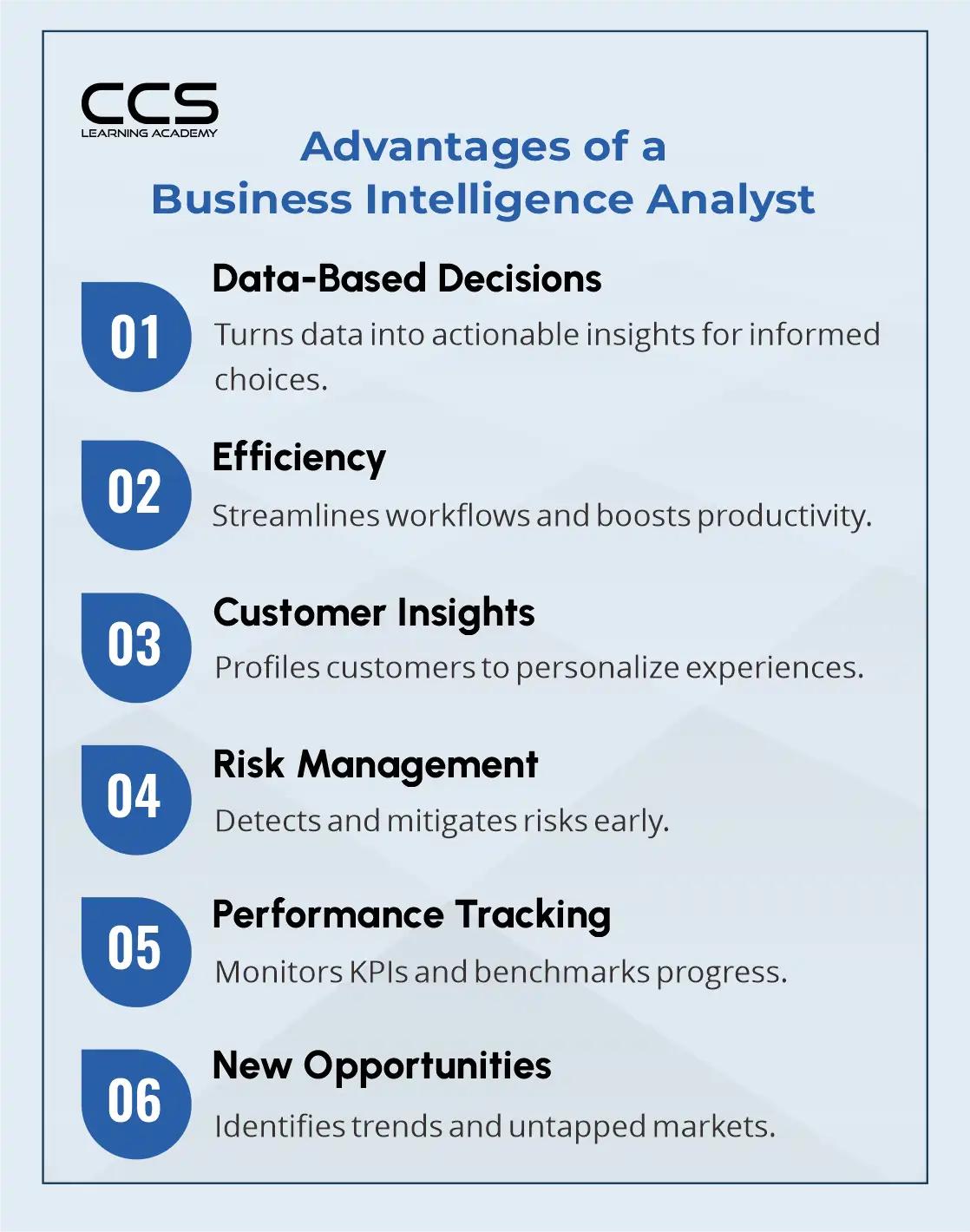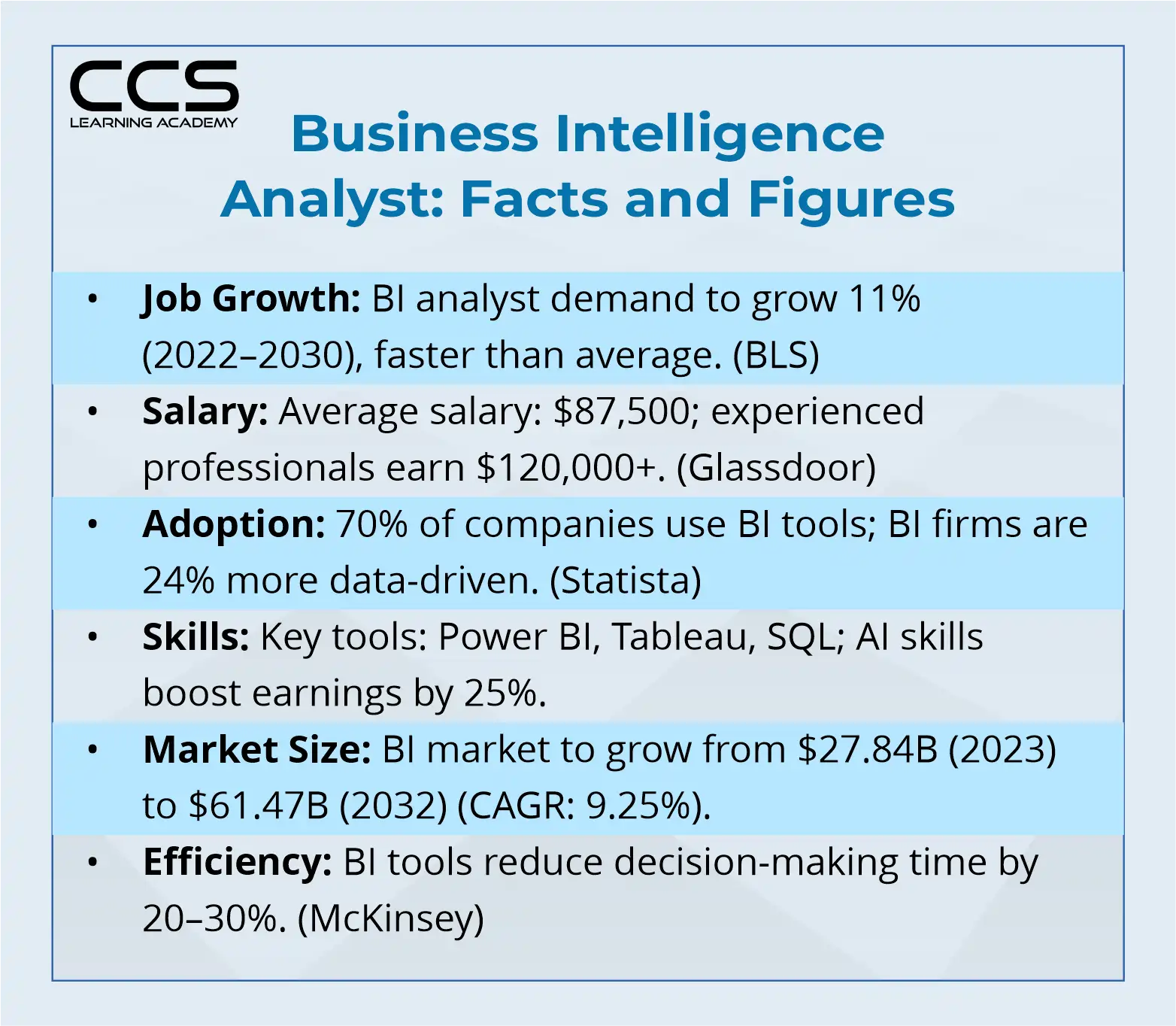Top 10 Business Intelligence Analyst Skills You Should Have in 2025
- -
- Time -

Business intelligence analysts play a crucial role in helping businesses make data-driven decisions. By analyzing internal and external data sources, BI analysts provide actionable insights that can improve operations, strategy, and productivity.
As data and technology continue to evolve rapidly, analytics skills are gaining more importance than ever for career success. That’s why people are doing Business Intelligence Courses and getting certified to increase the chances of getting hired.
What Is A Business Intelligence Analyst?

A Business Intelligence Analyst reviews and interprets data to help managers, executives and other business leaders make informed decisions that can improve business operations. They analyze both internal data like sales figures, marketing metrics, customer information as well as external data from industry reports, market research and customer surveys.
The internal data a BI Analyst examines could be things like numbers related to different business units, customer accounts, product sales, inventory levels, costs and profits over certain periods.
They study this operational data to find patterns, spot performance issues and come up with strategies that can enhance efficiency. The external data looks at industry and competitor insights, economic and demographic trends, consumer behavior analysis that provides a broader context for decision making.
By gathering all this relevant data from within and outside the organization, a BI Analyst gains a holistic view of how the business is performing against its goals. They then use their analytical skills to identify key factors influencing business results, like what products or customer segments are most profitable.
The Analyst also recognizes underperforming areas that need improvements. With their data-driven findings, a BI Analyst advises managers on opportunities for growth, areas requiring corrective actions and new initiatives to stay competitive.
Read more: Want to Become a Business Intelligence Analyst? Here’s How to Do It!
Advantages Of Business Intelligence Analyst
There are many advantages to having a skilled Business Intelligence Analyst as part of the team:
Data-Based Decision Making
A BI Analyst transforms mountains of numbers and facts into actionable business intelligence. They present conclusions and recommendations backed by real data analysis.
This helps management make well-informed decisions that have a higher chance of success since they are evidence-based rather than purely subjective. Data-led strategies are also more transparent and less prone to bias.
Increased Operational Efficiency
By unraveling insights from operational metrics, a BI Analyst guides optimization of core business processes. They can identify wasteful spending, redundant activities, underutilized resources and bottlenecks.
Management saves costs by streamlining operations based on such findings. Improved workflows boost productivity and free up resources for more strategic uses.
Enhanced Customer Insights
Customer data provides a goldmine for a skilled Analyst. They gain a comprehensive 360-degree view of the target audience by profiling demographics, purchase behaviors, preferences across all touchpoints.
Such deep customer understanding aids the development of personalized solutions and experiences. It also guides informed decisions around ideal target segments and go-to-market strategies. This helps boost customer retention, cross-sell rates and acquisition of new, high lifetime value clients.
Improved Risk Management
A Business Intelligence Analyst monitors various operational and external risks through comprehensive data analysis. They alert management to potential trouble spots in a timely manner.
Early risk detection allows for contingency planning and mitigation steps to be put in place. This enhances the organization’s ability to circumvent issues and ensures business continuity. Financial or compliance risks that could entail severe penalties are avoided through prudent, data-backed decisions.
Performance Tracking & Benchmarking
Key performance metrics are tracked over time by the Analyst to monitor goal accomplishments. Dashboards providing real-time performance insights keep everyone aligned. Industry benchmarking reveals an enterprise’s position versus competitors.
Underperforming metrics get addressed while outperforming areas deserve recognition. This spurs healthy competition and a cycle of continuous improvements. Standardized performance tracking also streamlines reporting and compliance.
Identification Of New Opportunities
A skilled Business Intelligence professional analyzes all available internal and external data sources to spot upcoming trends before competitors do. They identify white spaces, new markets and services to explore. Data projections help foresee obstacles in advance and prepare for them.
This gives the first-mover advantage to try innovative strategies and optimize results from new opportunities. A proactive, insights-led approach keeps the business future-proof from unexpected disruptions.
Read more: Business Intelligence vs Machine Learning: Key Differences Explained.
Top Business Intelligence Analyst Skills

Here are the top 10 skill sets business intelligence analysts should focus on developing in 2025:
1. Data Analysis
Data analysis sits at the core of any business intelligence analyst’s responsibilities. It involves systematically applying statistical and logical techniques to examine large datasets, identify meaningful patterns, and derive conclusions aimed at informing business decisions. Strong data analysis skills will remain crucial for BI professionals in 2025 and beyond.
Business intelligence analysts must be adept at cleaning, transforming, and modeling data. This involves tasks like data wrangling to identify missing values or outliers, data normalization to standardize formats, and data aggregation and grouping to derive insights at an appropriate level of granularity. Proficiency with data modeling techniques helps analysts understand relationships within datasets and structure information effectively for analysis.
Statistical analysis is another core capability. Techniques like descriptive statistics, hypothesis testing, correlation analysis, and predictive modeling enable analysts to quantify business performance, recognize trends, determine causal factors, and forecast future outcomes.
Statistical software like R and Python empower detailed and automated quantitative analysis of structured and unstructured information sources.
Visualization and presentation of insights are also important analytical skills. Through dashboards, reports and interactive data apps, BI analysts communicate complex findings to diverse internal audiences in an intuitive and understandable manner. This requires strong capacity for storytelling with data through effective visualization design.
As data volumes continue ballooning, machine learning and artificial intelligence will play a bigger role in automated data preparation, anomaly detection, and prescriptive analytics. Analysts proficient in these advanced techniques will be equipped to deliver faster, more sophisticated insights from huge and diverse data pools.
Overall, well-honed data analysis skill sets enable BI professionals to leverage data as a strategic asset. The ability to systematically interrogate information, discover nontrivial patterns and reliably quantify business performance will remain essential capabilities for the role in 2025 and beyond.
Read more: Best Data Analysis Methods: Choose the Right Technique.
2. SQL
Structured Query Language, commonly known as SQL, is the global standard for managing and interacting with relational databases. It continues being a core language for business intelligence analysts to extract insights from enterprise data warehouses and operational transactional systems.
Those aspiring to excel in the field must have strong knowledge of the fundamentals of SQL. This includes proficiency with commands like SELECT, FROM, WHERE, GROUP BY, HAVING, ORDER BY, JOIN types (INNER, LEFT, RIGHT, FULL OUTER), and set operations (UNION, INTERSECT). Experience with non-procedural extensions in variants like T-SQL and PL/SQL is also advantageous.
More advanced skills like subqueries, common table expressions, window functions, pivoting and unpivoting of datasets further enhance an analyst’s ability to wrangle complex business questions. Integration with programming environments through ODBC/JDBC protocols enables direct querying from statistical packages and custom reporting/modeling applications.
Understanding database concepts like normalization, denormalization, schema design, integrity constraints and query optimization is highly valuable. Data modeling expertise allows analysts to structure relational stores efficiently as sources for reporting and analytics.
Proficiency across major commercial and open-source database platforms like Microsoft SQL Server, Oracle Database, PostgreSQL and others ensures broad applicability to various data architecture landscapes. Certification in SQL helps strengthen skills and marketability.
Overall, in 2024 and beyond, SQL mastery is crucial for business intelligence analysts to autonomously analyze enterprise datasets and drive insights directly from major transaction and analytics systems. Strong relational database querying skills will continue empowering the role.
3. Data Visualization
Effectively visualizing information promotes faster understanding and better decision making. For this reason, expertise in data visualization techniques remains a core competency for business intelligence professionals. Well-honed skills in industry-leading visualization platforms continue to hold value for analysts.
Tableau and Power BI are amongst the most popular options. Mastery of these tools involves proficiency in dashboard design, report authoring, customized data blending, advanced analytics including forecasting and predictive modeling, development of reusable data assets, and management of data security and governance.
Analytical skills continue applying – visualizations should tell clear stories through intentional design of charts, graphs, maps and other visual elements. Techniques like consolidation of large data volumes into high-level visual summaries aid comprehending breadth of information.
Interactive elements promote deeper exploration and ongoing collaboration. Dynamic filters, drill-downs, highlight actions, annotations and commentary features allow stakeholders self-serve discovery of insights.
Programming skills correlate – abilities to extend dashboarding using custom visuals, macros, parameterizing and Tableau/R integration deliver unparalleled analysis. Automation of visualization workflows further increases scalability.
Data literacy is important – communicating context around meaning, relevance, limitations and next steps for visual findings helps guide effective decision making.
Strong visualization aptitude, both at strategic and technical levels, will remain pivotal for driving business value from organizational intelligence and propelling the analyst role to greater prominence.
Read more: Business Intelligence vs Big Data: Top Comparison Guide.
4. Programming Languages
While BI tools abstract away much complexity, programming languages give analysts greater flexibility to work directly with diverse data sources, develop custom solutions, and expand the scope of analytical possibilities. Core languages like Python and R have become invaluable in the modern data professional’s toolkit.
Python skills provide multi-purpose potential across the entire analytics life cycle. Libraries like Pandas, NumPy, Matplotlib and Seaborn support efficient data wrangling, transformation, modeling and visualization. Integration with services and databases promotes automation. Web scraping, automation of manual processes and API-driven reporting are areas seeing increased application.
R’s strength lies in advanced statistical analysis, machine learning and predictive modeling capabilities. Packages like ggplot2, tidyverse and caret facilitate publishing professional, interactive reports and deploying models into production. Shiny apps package R functions into fully operational web applications.
Programming fundamentals such as data structures, control flow, modular design and version control continue having applicability across languages. Understanding programming paradigms like procedural, object-oriented and functional aids selecting the right tool. Debugging, testing and documentation best practices are also valuable skills.
Emerging technologies increasingly require coding skills – full-stack skills for building customized data apps, SQL for non-SQL data, and Python/R for advanced machine learning, deep learning and natural language processing will hold demand.
5. Data Management
As data sources and connectivity increase in complexity, business intelligence analysts must strengthen data management capabilities. Sound data integration, quality, architecture and governance are core skills that will allow analysts to work seamlessly across teams and comprehend information flows.
Crucial data management techniques include data modeling, extract-transform-load (ETL) process design, data security, and standards development. Data modeling involves conceptualizing entities and relationships within corporate databases to support reporting and analysis.
Analysts design ETL processes to automate extraction of data from various sources, transformation into a common format, and loading into a data warehouse or lake. This ensures analysts and others can leverage clean, consistent data.
Strong data security and access controls are also paramount as more sensitive customer and transactional information resides in analytics platforms. Analysts help form data policies and implement authentication/authorization procedures to safeguard valuable assets.
Development of data standards involves socializing common metadata, structures and naming conventions throughout an organization. This facilitates sharing and reuse of data across departments and systems.
As datasets continue expanding in size and originating in more distributed environments like cloud data lakes, business intelligence specialists assuming data management responsibilities will play strategic roles. They can aid organizations in maximizing value extracted from extensive and growing corporate data resources through implementing well-designed governance, integration and quality measures.

Communication
Success for business intelligence analysts predominantly rests upon communicating findings effectively to diverse audiences, rather than solely possessing technical skills. By 2024, outstanding presentation, documentation and narrative development abilities will be increasingly imperative for analysts seeking influence.
Concisely yet persuasively portraying analytic insights and proposed actions empowers business partners to make informed decisions. Analysts must excel at tailored deliverable creation, active listening during discussions, and collaboration on cross-functional teams. Presentation formats should convey meaningful conclusions from complex analyses in a simplified, easily digestible manner.
Supplementary documentation allows stakeholders to reference analysis details later while following summarized recommendations. Narratives incorporated into deliverables help contextualize results and proposed strategies within realistic scenarios, enhancing recall and utility. Regular communication maintains relationships and tracks decision outcomes.
Analysts able to flexibly customize communication approaches based on each partner’s preferences, background and priorities will prove most valuable. Conveying an approachable demeanor helps establish an analyst as a trusted advisor, versus just a provider of periodic reports. These interpersonal skills are paramount for empowering impact from data-driven insights.
Read more: Top 10 Business Analytics Tools Used by Businesses.
7. Domain Knowledge
Deeper industry and organizational understanding provides “live” context when analyzing enterprise data. By 2024, business intelligence analysts focusing on rapidly comprehending their company’s domain via diverse immersion tactics will gain significant competitive advantages.
Techniques like conducting informational interviews, attending internal training sessions, and perusing documentation foster in-depth knowledge of products, customers, operations, culture and strategic goals.
This domain familiarity, bolstered by strong general business acumen, enables analysts to shape recommendations addressing each partner’s true priorities. Continuous learning also keeps analysts apprised of competitive dynamics and trends to advise from an informed position.
Remaining steeped in a company’s domain context allows analysts to ask more insightful questions of data. They can recognize peculiarities in results warranting further investigation instead of accepting anomalies at face value.
Findings are framed within the organization’s realistic constraints and opportunities. Rather than analyses perceived as detached, this understanding positions analysts as strategic thought partners for driving key initiatives.
7. Machine Learning
As machine learning and AI transform analytics capabilities over the next few years, familiarity with core algorithms and techniques will be essential for business intelligence specialists. Hands-on application experience applying supervised, unsupervised and reinforcement learning methods lays a foundation for various roles.
Analysts able to interpret “black box” machine learning results and have confidence in automated decisions hold significant value. A basic understanding of model development best practices like data preprocessing, model selection, parameter tuning, validation and deployment is vital.
Keeping abreast of state-of-the-art predictive modeling innovations and use cases preps analysts to advise on high-level ML strategies. Some may specialize in ML roles overseeing end-to-end deployment of predictive solutions. Others leverage machine learning as one analytical tool among many, knowing when and how various techniques fit particular business problems.
Overall success in coming years depends on a blend of technical fluency and interpersonal acumen. Business intelligence analysts cultivating expertise across these evolving skill areas can act as valued strategic partners driving data-powered transformation.
9. Cloud Platforms
Cloud platforms have revolutionized how businesses store, access and integrate data. Skilled deployment and management of cloud analytics environments including AWS, Azure, and GCP has become a critical skill for business intelligence analysts. Platforms like these allow for flexible, scalable and secure data infrastructure that can adapt based on business needs. They also enable seamless collaboration globally.
Cloud platforms streamline processes for analysts by providing analytics-optimized data warehouses, lakes and other services that handle everything from raw data ingestion to complex modeling and visualization.
This vastly improves efficiency compared to on-premise systems that require infrastructure maintenance. Skilled analysts can build cloud architectures that optimize performance and lower costs through services like auto-scaling, serverless computing and pay-as-you-go pricing.
As businesses increasingly rely on cloud-based data tools, analysts driving strategic cloud migrations ensure a smooth transition with minimal disruptions. They can estimate workload capacities, plan hybrid/multi-cloud deployments, test disaster recovery and ensure compliance and governance. Such planned migrations unlock greater value from data over time through easier upgrades, innovation and expanded analytics use cases.
10. Ethical Considerations
As artificial intelligence and machine learning become mainstream in data analytics, understanding ethical implications is imperative. Automated systems and algorithms may unintentionally discriminate, violate privacy or spread misinformation without checks.
Skilled business intelligence analysts consider how their work may impact people. They assess algorithmic biases to prevent unfair outcomes, ensure privacy through techniques like anonymization and differential privacy, and remain objective by evaluating models regularly.
Analysts also focus on transparency through documentation of data sources, model assumptions and oversight. User privacy and consent frameworks become important as personal data powers more decisions. Governance helps ensure appropriate use and prevent legal issues from emerging analytics.
As data tools grow more autonomous, these capabilities will be crucial for analysts to guide innovation responsibly and avoid unintended harm. Fostering accountability and responsibility in data science is key to its trustworthy application and social benefit.
Read more: Business Intelligence vs Predictive Analytics: Key Differences Explained.
Conclusion
In an age where data drives decisions, business intelligence analysts play an invaluable role in helping companies realize evidence-based strategies. This article discussed the top skills BI analysts should focus on developing to stay successful in 2025. Staying current on emerging techniques, problem-solving creatively, and crafting influence ensure strategic career relevance. Above skills deliver value through multidimensional analytics expertise.
The role of a Business Intelligence Analyst has never been more vital across all sectors. With their unique ability to unlock value from structured and unstructured data, BI analysts position themselves at the heart of key business decisions. From optimizing processes to discovering new opportunities, companies stand to gain a competitive advantage from skilled BI professionals.
Stay ahead in 2025 with the top BI skills every analyst needs. Enroll in our Data Analytics & Engineering Bootcamp to gain hands-on expertise and accelerate your career!
FAQ
A: To stay ahead, BI Analysts must continually upgrade their skills in areas like advanced data analytics, machine learning, and cloud technologies. Mastering visualization tools and developing a deep understanding of business strategy will also be crucial for success in 2025.
A: In 2025, AI and machine learning will significantly enhance BI Analysts’ ability to interpret complex datasets, automate data collection, and improve predictive analytics. Analysts will need to be proficient in integrating AI tools to streamline reporting and decision-making processes.
A: Data visualization remains a critical skill because it helps BI Analysts present complex insights in a way that is easy to understand for non-technical stakeholders. In 2025, with growing data volumes, effective visualization will be even more crucial for decision-makers to grasp key insights quickly.
A: By 2025, proficiency in advanced tools like Power BI, Tableau, SQL, and Python will be essential. Analysts should also become familiar with emerging technologies like cloud-based BI platforms and self-service analytics tools.
A: BI Analysts should focus on understanding the business context behind the data, develop a deep knowledge of industry trends, and improve collaboration with decision-makers. By combining technical skills with strategic thinking, analysts can drive more effective, data-driven decisions.
A: Cloud computing will revolutionize data storage and processing, making it easier for BI Analysts to access and analyze real-time data. Analysts should be familiar with cloud-based platforms like AWS or Azure, which offer scalability and flexibility to manage large datasets.
A: Soft skills like communication, teamwork, and critical thinking will be increasingly important in 2025. BI Analysts must effectively communicate complex insights to both technical and non-technical stakeholders and collaborate with cross-functional teams to drive business strategies.
A: In 2025, BI Analysts will face challenges such as dealing with massive data volumes and ensuring data security. Overcoming these challenges will require expertise in big data technologies, data privacy regulations, and strong collaboration with IT teams to maintain robust security protocols.
A: Predictive analytics will allow BI Analysts to forecast future trends, identify opportunities, and mitigate risks. By mastering predictive modeling techniques, analysts can provide more actionable insights to businesses, enhancing their role in strategic decision-making.
A: BI Analysts should have a basic understanding of machine learning algorithms and data modeling to leverage the power of AI in analyzing large datasets. Skills in tools like TensorFlow and scikit-learn will be essential for creating and implementing predictive models.






